Click below to jump to an article of interest.
ROS-I Consortium Celebrates First Decade
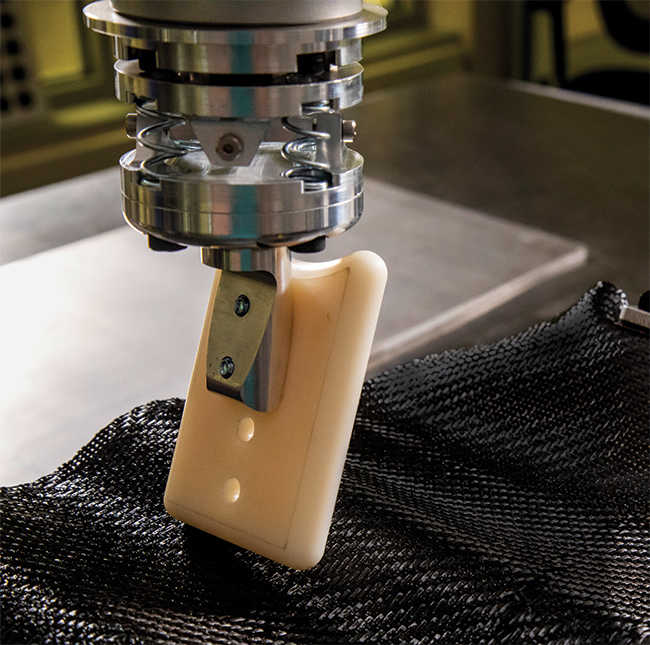
The ROS-Industrial consortium, a project dedicated to advancing open-source robotics for manufacturing and industry, celebrated its 10th anniversary at its 2023 annual meeting. The consortium has grown from 14 member organizations in 2013 to over 85 organizations, representing a broad range of industries and academic institutions. ROS-Industrial has also expanded to include member consortia in Europe and the Asia-Pacific region, attracting members globally.
ROS-Industrial’s repositories of opensource robotics software tools are regularly updated and customized, advancing industrial robotics and enabling robots to perform new and diverse tasks, such as manufacturing aerospace composites (pictured). Members have access to a range of tools and activities, such as technical roadmapping, workforce development and developer meetings. Focused technical projects benefit the consortium and the community while supporting growth of the software repository.
NPSS
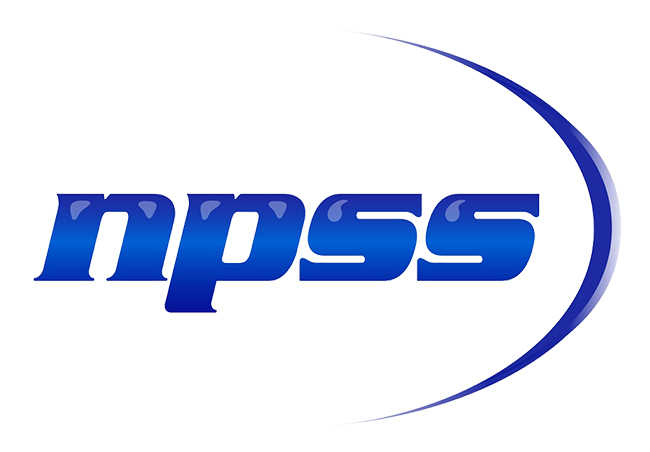
Since 2013, SwRI has managed aerospace consortium — the Numerical Propulsion System Simulation or NPSS® — for its members. NPSS is an advanced object-oriented thermodynamic modeling environment used by the aerospace industry to simulate turbomachinery, air-breathing propulsion systems, liquid rocket engines and engine control systems. The flow-network tool also can be applied to model refrigeration cycles, multiphase heat transfer systems, vehicle emission analyses or supercritical carbon dioxide (sCO2) power cycles.
Originally developed at NASA’s Glenn Research Center in 1995, NPSS allows machinery manufacturers to model and integrate critical performance information with infrastructure models. SwRI’s NPSS team maintains the software and creates new features. In 2020, the consortium developed NPSS integrated development environment (IDE) to make the software more accessible to new and casual users while easing the process of developing new models and investigating existing models. The consortium also develops and maintains NPSS EMI — for Elements, Models and Interfaces — which enhances the engineering functions within NPSS.
Questions about NPSS? Contact Griffin Beck or +1 210 522 2509.
Novel Direction-Finding Technology Wins R&D 100 Award
R&D World Magazine has recognized SwRI’s Wideband Conformal Continuous-Slot Antenna Array as one of the 100 most significant innovations for 2023. Since 1971, SwRI has received 52 R&D 100 awards.
This state-of-the-art technology provides naval ships with high-performance, high-frequency radio frequency direction-finding (DF) and signal acquisition while conforming around shipboard mast structures. Modern-day DF systems determine the direction of enemy combatants, provide situational awareness and serve to locate emergency transponders for search-and-rescue operations.
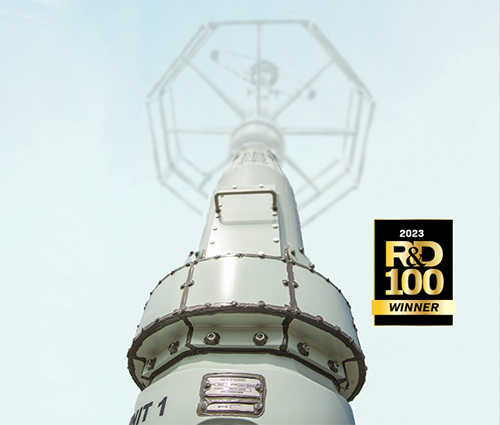
SwRI’s state-of-the-art Wideband Conformal Continuous-Slot Antenna Array, jutting out from near the base of this mast, provides naval ships with high-performance, high-frequency radio frequency direction-finding and signals acquisition while conforming around shipboard mast structures.
“The operating frequency and bandwidth of modern radio frequency, or RF, communications signals are trending increasingly higher, outpacing the performance of modern direction-finding antennas,” said SwRI Staff Engineer Patrick Siemsen, who led the project. “Current DF antennas must maintain precise electromagnetic spacing between array antenna elements to prevent grating lobes or ripples in the beam-formed antenna patterns, which can cause performance issues.”
Traditional shipboard high-frequency DF antennas are typically mounted at the top of a mast due to inter-antenna element spacing requirements or situated on a yardarm off the side of the mast, a location that can cause structural blockages, reduced sensitivity and degraded performance.
The Wideband Conformal Continuous-Slot Antenna Array, released as part of SwRI’s AS-750 family of advanced antenna arrays, overcomes the performance issues commonly encountered at higher frequencies. The array was designed using electromagnetic modeling software and takes inspiration from an unorthodox concept for a wideband antenna array originally conceived by electronics engineer Harold Wheeler in 1948, which until now was largely theoretical.
“Our AS-750 antenna arrays use a series of continuous slot antennas with closely spaced antenna feeds around the perimeter array,” Siemsen said. “The close spacing is possible through symmetrical, dual-ring microstrip corporate feed networks. We can conform the antenna array around the support mast without losing processing performance, and the design allows higher-priority navigational and threat-warning systems to be mounted above it.”
The SwRI Wideband Conformal Continuous-Slot Antenna Array enables existing and future naval platforms to support the need for communications intelligence systems to perform the previously unachievable high-performance signals processing of increasingly sophisticated ultra-high and super-high frequency signals. The antenna array is only seven inches high and requires a fraction of the space required by comparable arrays without sacrificing the durability necessary for the demands of a naval shipboard environment.
Though designed for naval shipboard signals intelligence applications, the AS-750 antenna arrays are suitable for other uses and installations where similar mounting restrictions apply or when low-profile packaging is desired. The SwRI team is investigating other applications for the antenna arrays, including airborne and land-based uses.
Though designed for naval shipboard signals intelligence applications, the AS-750 antenna arrays are suitable for other uses and installations where similar mounting restrictions apply or when low-profile packaging is desired. The SwRI team is investigating other applications for the antenna arrays, including airborne and land-based uses.
NASA Funds DIMPLE Lunar Lander/Rover
NASA has selected SwRI to lead a $50 million lunar lander/rover instrument suite, Dating an Irregular Mare Patch with a Lunar Explorer, or DIMPLE, designed to understand if the Moon has been volcanically active in the geologically recent past. DIMPLE, which was developed by SwRI, will use cameras and radioisotope-based dating to determine the age and composition of an anomalously young-looking patch of lunar basalt named Ina.
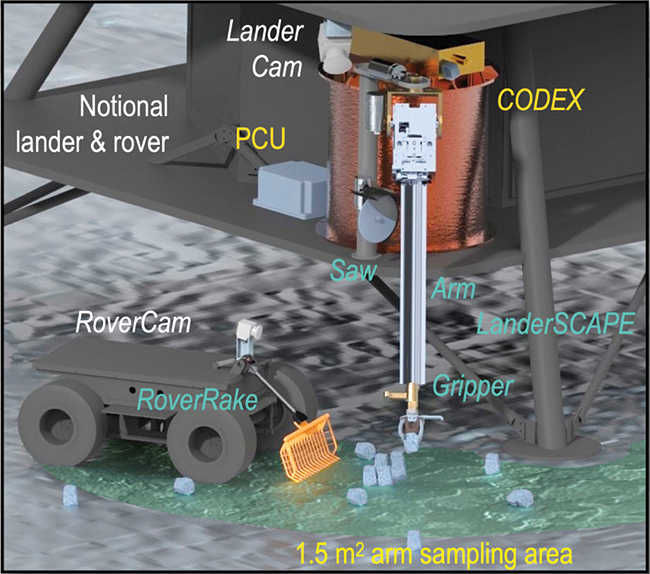
Courtesy of Lockheed Martin/SwRI/University of Bern/The Aerospace Corporation/ NASA/GSFC/Arizona State University
A camera, sample collection arm and the CODEX instrument will remain on the DIMPLE lander, while a rover equipped with a camera and rake will scoop and transport samples back to the lander instruments for detailed study.
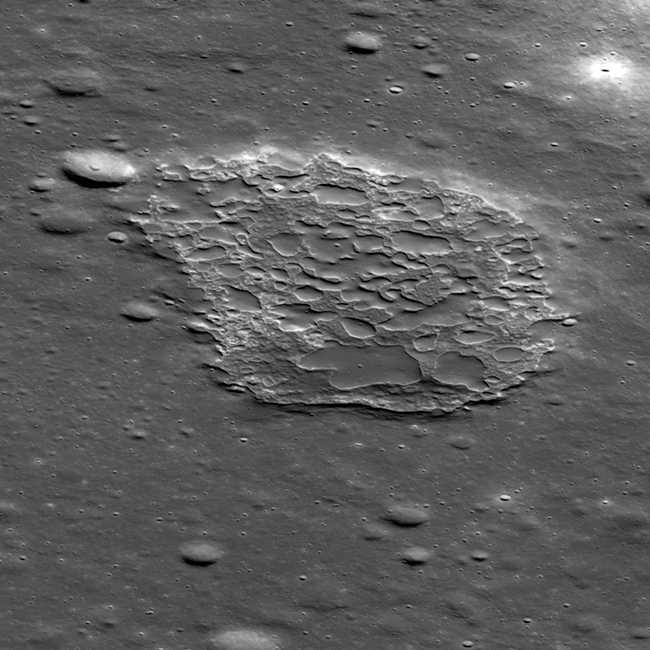
Courtesy of Lockheed Martin/SwRI/University of Bern/The Aerospace Corporation/ NASA/GSFC/Arizona State University
The DIMPLE lunar lander/rover instrument suite will use a camera and radioisotope-based dating to determine the age and composition of this mysteriously young-looking patch of basalt known as Ina, shown here in a Lunar Reconnaissance Orbiter image.
DIMPLE will date the rocks at Ina directly using the first-ever purpose-built radioisotope rock dating instrument for use in space, called CODEX (Chemistry Organic and Dating Experiment). Ina is an enigmatic formation of unusually smooth mounds surrounded by rough troughs, all inside the central crater of a large volcano. Ina looks much younger than other places on the Moon because it has very few impact craters. Impact craters build up on the lunar surface over time, so older surfaces generally have more impact craters compared to younger surfaces.
“This challenges our understanding of lunar geochemical evolution, since a geologically recent eruption requires unexpectedly long-lived heat sources in the lunar interior,” said SwRI Institute Scientist Dr. F. Scott Anderson, principal investigator of DIMPLE. “If Ina really is as young as it appears, that means that the Moon has been volcanically active much more recently than scientists have thought. Or, if we find that Ina is as old as typical lunar rocks, that indicates that the material properties of certain rocks can fool us, if we are not careful, as we try to understand the ages of planetary surfaces throughout the solar system.”
If rock formations like Ina do not give rise to impact craters, or do not preserve them over the eons, then some current ideas about solar system history could be wrong. The CODEX instrument exploits the natural radioactive decay of rubidium into strontium as a measure of how much time has elapsed since a rock sample formed. The SwRI-led team has been developing CODEX for two decades.
“Dating is a challenging process. Traditional techniques are not easily adapted to spaceflight, requiring a sizable laboratory and several months to determine a date,” Anderson said. “By contrast, the entire DIMPLE payload is going to weigh less than 50 kilograms and needs to run autonomously on the Moon. In our lab, we have shown that CODEX can accurately date rock samples like those we expect to find at Ina with a precision of better than ±375 million years, which is more than sufficient to situate the origin of Ina in the billions-of-years-long history of the Moon.”
DIMPLE is part of NASA’s Payloads and Research Investigations on the Surface of the Moon (PRISM), which will be delivered to Ina through the Commercial Lunar Payload Services (CLPS) initiative. The DIMPLE team includes The Aerospace Corporation, the University of Bern, Colgate University and Lockheed Martin.

ENABLE-ing Enhanced Performance, Reduced Injury Risk
SwRI recently launched its new Engine for Automatic Biomechanical Evaluation (ENABLE™) markerless biomechanics system.
ENABLE is a user-friendly, markerless-motion-capture system that leverages artificial intelligence, computer vision algorithms and biomechanical modeling. The key advantage of ENABLE is it efficiently captures motion without requiring physical body markers to be attached to a human subject.
“Following years of internal research and applied client projects, SwRI has made ENABLE commercially available for biomechanical analysis in sports, medicine, research and other human performance applications,” said Institute Engineer Dr. Dan Nicolella. “We are excited about all the potential applications from sports to military medicine.”
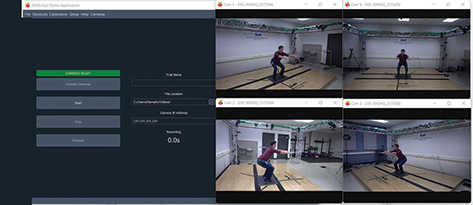
The SwRI-developed Engine for Automatic Biomechanical Evaluation (ENABLE™) markerless biomechanics software has an optional graphic user interface (GUI). Images at left are raw data of athlete performance. Images on right depict kinematics from video inputs.

This portable, user-friendly system incorporates the ENABLE™ analysis tool to improve pitchers’ accuracy and alter their mechanics to reduce injury risk.
Historically, sports scientists have relied on the tedious process of attaching physical markers to a human subject at precise locations on the body to capture kinematics data with special infrared cameras. ENABLE circumvents physical markers by leveraging novel computer vision algorithms that process standard video. An SwRI-developed neural network identifies and tracks over 80 virtual points on the human body including the locations of wrists, elbows, knees, ankles and other joint positions.
ENABLE combines novel artificial intelligence algorithms with OpenSim biomechanical modeling to analyze the properties of human physical motion, or kinematics, from standard video. Sometimes known as the geometry of motion, kinematics enables the mathematical quantification of walking, running and other precise physical movements. SwRI used internal funding to develop ENABLE into a portable, user-friendly system that can, for instance, help improve pitchers’ accuracy and alter their mechanics to reduce injury.
“With so many open questions about the underlying mechanisms driving pitching injury and actions that can prevent injury, we wanted to design an optimal control framework to investigate the cause-effect relationship between pitching mechanics and injury risk,” said Research Engineer Ty Templin. “We ran optimization scenarios to make subtle changes to the pitchers’ motions and mechanics to minimize shoulder torque, which was our metric for injury. We then maximized the hand velocity, which was our metric for performance.”
SwRI’s markerless biomechanics system is unique in its forward dynamics optimization capability, which allows users to examine scenarios that incorporate hypothetical changes to the subject’s movements. For example, researchers found that a straightened stride leg more efficiently transfers energy into the pitch.
“We trained ENABLE to see those locations in views from multiple cameras. ENABLE robustly computes the 3D location of each virtual point on the body to accurately map the subject’s motion,” said Omar Medjaouri, an SwRI senior research engineer who specializes in computer vision. “Combining computer vision and biomechanics, ENABLE creates a personalized biomechanical model of each subject and uses this model to constrain the resulting movement to the physical reality of the human body to output kinematics that are highly accurate.”
Templin, Nicolella and their colleagues plan to investigate the various benefits the system can offer, including studying the movements of basketball players.
Ancient, High-Energy Impacts Likely Fueled Venus Volcanism
An SwRI-led team has modeled the early impact history of Venus to explain how Earth’s sister planet has maintained a youthful surface despite lacking plate tectonics. The team compared the early collision histories of the two bodies and determined that Venus likely experienced higher-speed, higher-energy impacts creating a superheated core that promoted extended volcanism and resurfaced the planet.
“One of the mysteries of the inner solar system is that, despite their similar size and bulk density, Earth and Venus operate in strikingly distinct ways, particularly affecting the processes that move materials through a planet,” said Dr. Simone Marchi, lead author of a new paper about these findings in Nature Astronomy.
The Earth’s shifting plates continuously reshape its surface as chunks of the crust collide to form mountain ranges and, in places, promote volcanism. Venus has more volcanos than any other planet in the solar system but has only one continuous plate for its surface. More than 80,000 volcanos — 60 times more than Earth — have played a major role in renewing the planet’s surface through floods of lava, which may continue to this day. Previous simulations struggled to create scenarios to support this level of volcanism.
“Our latest models show that long-lived volcanism driven by early, energetic collisions on Venus offer a compelling explanation for its young surface age,” said Professor Jun Korenaga, a co-author from Yale University. “This massive volcanic activity is fueled by a superheated core, resulting in vigorous internal melting.”
Earth and Venus formed in the same neighborhood of the solar system as solid materials collided with each other and gradually combined to form the two rocky planets. The slight differences in the planets’ distances from the Sun changed their impact histories, particularly the number and outcome of these events. These differences arise because Venus is closer to the Sun and moves faster around it, energizing impact conditions. In addition, the tail of collisional growth is typically dominated by impactors originating from beyond Earth’s orbit that require higher orbital eccentricities to collide with Venus rather than Earth, resulting in more powerful impacts.
“Higher impact velocities melt more silicate, melting as much as 82% of Venus’ mantle,” said Dr. Raluca Rufu, a Sagan Fellow and SwRI co-author. “This produces a mixed mantle of molten materials redistributed globally and a superheated core.”
If impacts on Venus had significantly higher velocity than on Earth, a few large impacts could have had drastically different outcomes, with important implications for the subsequent geophysical evolution. The multidisciplinary team combined expertise in large-scale collision modeling and geodynamic processes to assess the consequences of those collisions for the long-term evolution of Venus.
And the timing of this new explanation is serendipitous. In 2021, NASA committed to two new Venus missions, VERITAS and DAVINCI, while the European Space Agency is planning another called EnVision.
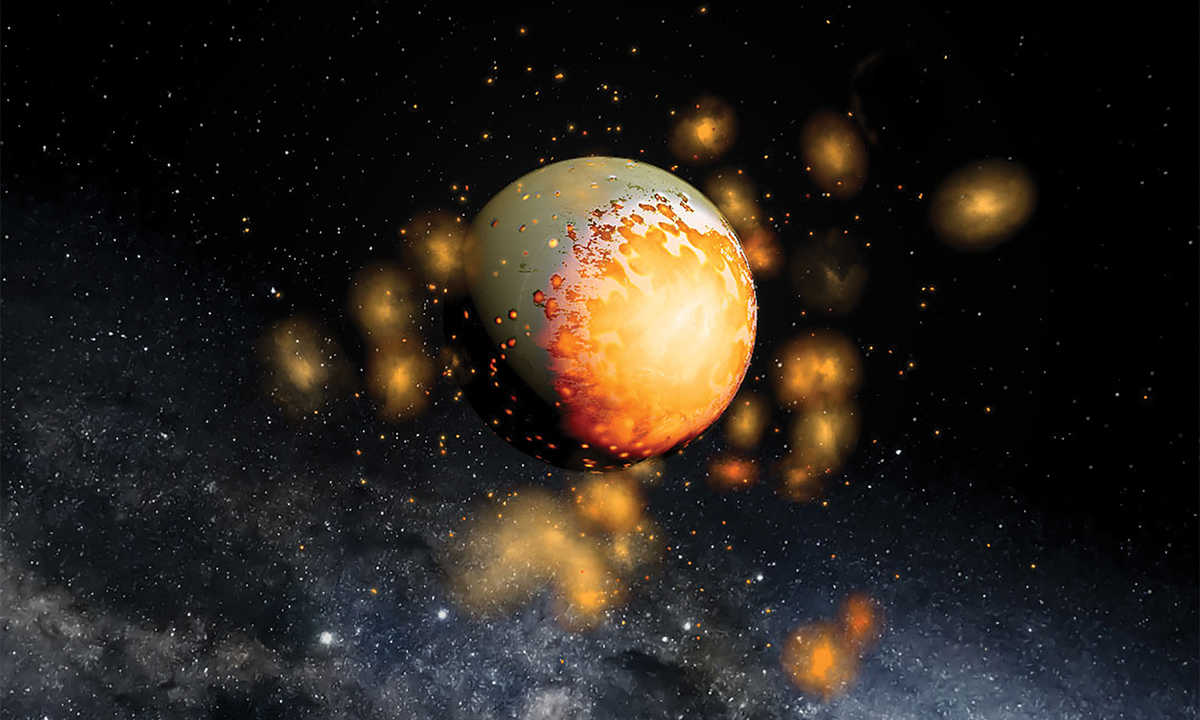
Exciting Enceladus Science
The search for extraterrestrial life in our solar system just got more exciting with new findings about the environment around Enceladus. A team of scientists including SwRI’s Dr. Christopher Glein has discovered new evidence that the subsurface ocean of Saturn’s moon Enceladus contains a key building block for life. The team directly detected phosphorus in the form of phosphates originating from the moon’s ice-covered global ocean using data from NASA’s Cassini mission.
In addition, two SwRI scientists were part of a James Webb Space Telescope (JWST) team that observed a towering plume of water vapor more than 6,000 miles long — roughly the distance from the U.S. to Japan — spewing from the surface of Enceladus. In light of this NASA JWST Cycle 1 discovery, Glein also received a Cycle 2 allocation to study the plume as well as key chemical compounds on the surface, to better understand the potential habitability of this ocean world.
During its 13-year reconnaissance of the Saturn system, the Cassini spacecraft discovered that Enceladus has a subsurface ocean of liquid water, and Cassini analyzed samples as plumes of ice grains and water vapor erupted into space from cracks in the moon’s icy surface.
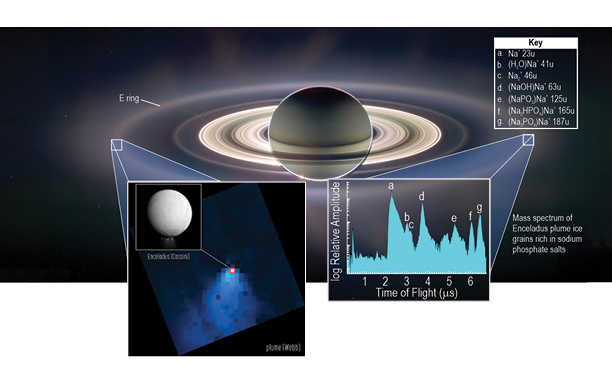
Courtesy of NASA/ESA/CSA/Alyssa Pagan (STSCI)/Geronimo Villanueva (NASA-GSFC)/SwRI/Freie Universität Berlin
New JWST findings show the plume of water escaping from Enceladus extends 6,000 miles or more than 40 times the moon’s size and feeds Saturn’s E ring.
Scientists found phosphorus, a key building block for life, in ice grains sourced by plume eruptions from the subsurface ocean of Saturn’s small moon, Enceladus.
“In 2020 (published in 2022), we used geochemical modeling to predict that phosphorus should be abundant in Enceladus’ ocean,” said Glein, a leading expert in astro-oceanography. He is a co-author of a paper in the journal Nature describing this research. “Now, we have found abundant phosphorus in plume ice samples spraying out of the subsurface ocean.”
The Webb project revealed a new story about Enceladus and how it feeds the water supply for the entire system of Saturn and its rings. As Enceladus whips around the gas giant in just 33 hours, the moon spews water, leaving a halo, almost like a donut, in its wake. The plume is not only huge, but the water spreads across Saturn’s dense E ring. JWST data indicate that roughly 30 percent of the water stays in the moon’s wake, while the other 70 percent escapes to supply the rest of the Saturnian system.
“The Webb observations, for the first time, are visually illustrating how the moon’s water vapor plumes are playing a role in the formation of the torus,” said SwRI’s Dr. Silvia Protopapa, an expert in the compositional analysis of icy bodies in the solar system who was also on the Cycle 1 team. Spurred by the incredible findings from Webb’s first fleeting glimpse of Enceladus, Glein is leading the same team that will observe Enceladus again with JWST in the next year.
The new observations will provide the best remote opportunity to search for habitability indicators on the surface, by boosting the signal-to-noise ratio by up to a factor of 10 compared with Cycle 1. Understanding the time variability of outgassing is also important to plan for future planetary science missions that target Enceladus’ plume, such as the proposed search-for-life mission, Orbilander.
Measuring Hydrogen/Natural Gas Bends
Southwest Research Institute is expanding its flow meter research to address the impact of introducing hydrogen and natural gas blends into the residential and commercial energy mix. Working with NYSEARCH, a nonprofit research and development organization for the gas industry, SwRI will measure the energy content of blended gas to assess the accuracy of current flow meter technology for monitoring usage in homes.
Natural gas is widely used to power appliances and heat homes. In the next decade, some gas companies plan to blend hydrogen gas with natural gas to curb carbon emissions. Because the density of the resulting blends would be significantly different than natural gas, flow meters calibrated to measure the flow of natural gas may have some error when measuring blended gases.
Accurately measuring energy usage with flow meter technology depends on three things. First, SwRI must determine the energy content of blended gas. Second, the team must verify that flow meters accurately read volumetric flow rates. Third, they will measure the density of the blended gas to calculate the mass flow rate.
The team is characterizing the accuracy of three flow meter technologies in a blended gas environment and experimentally gathering density data for hydrogen and natural gas blends for residential applications. SwRI researchers are also investigating the same gas properties for renewable natural gas blends, such as those from landfills and dairy farms.
“We need to address many questions about blended gas and how it affects equipment,” said Angel Wileman, manager of SwRI’s Thermofluids Section. “When it comes down to it, it will affect people’s pocketbooks. Flow meters determine how much gas a distribution company delivers to a consumer, so ensuring that consumers are charged accurately is vital as we move toward using blended gas.”

Telescope Campaign Observes Jupiter's Volcanic Moon Io
The Space Telescope Science Institute recently awarded SwRI a project to use the Hubble and James Webb telescopes to remotely study Io, the most volcanically active body in the solar system. The study will complement the upcoming flybys of the Jupiter moon by NASA’s Juno spacecraft, providing insights into Io’s contributions to the plasma environment around Jupiter.
The Space Telescope Science Institute recently awarded SwRI a project to use the Hubble and James Webb telescopes to remotely study Io, the most volcanically active body in the solar system. The study will complement the upcoming flybys of the Jupiter moon by NASA’s Juno spacecraft, providing insights into Io’s contributions to the plasma environment around Jupiter.

Courtesy of NASA/JPL-CALTECH/SwRI/ASI/INAF/JIRAM /John Spencer
SwRI is leading a study to understand how Io, the most volcanic body in our solar system, contributes to Jupiter’s plasmasphere. Juno’s JIRAM instrument images Io’s hot spots, data that will be complemented by Hubble and Webb telescope datasets.
Io’s escaping atmosphere is the dominant source of material in the Jovian magnetosphere, a vast bubble of charged particles swirling around the gas giant. However, the connection between the volcanos, surface volatiles, atmosphere and magnetospheric plasma interaction to Io’s extended neutral clouds, the Io Plasma Torus (IPT) and Jupiter’s ionosphere remains difficult to quantify and understand. The IPT is a donut-shaped cloud of ions and electrons surrounding Jupiter, created when atmospheric gases escaping from Io are ionized. Electrons collide with the ions, which absorb energy from the collisions and release it as ultraviolet light, which can be detected by telescopes.
“The couplings between time-variable processes are central to understanding the Jupiter system holistically,” said Dr. Fran Bagenal, the project’s co-principal investigator from the University of Colorado at Boulder. “For example, how much sulfur is transported from Io to Europa’s surface? How do auroral features on Io compare with auroras on Earth — the northern lights — and Jupiter?”
Smart Vehicles Improve Overall Traffic Flow
An SwRI project funded by the U.S. Department of Energy (DOE) has demonstrated an average of 15% energy savings when vehicles outfitted with connected and automated vehicle (CAV) systems are introduced into traffic on public roadways. CAVs use wireless smart technology to communicate with other CAVs and traffic infrastructure. SwRI received a $3.2 million award from the DOE’s Energy Efficient Mobility Systems (EEMS) initiative to study the energy implications of smart vehicles and intelligent infrastructure solutions within the broader traffic context.

SwRI-DOE project demonstrated overall energy savings of 15% when vehicles outfitted with connected and automated vehicle systems, or CAVs, are introduced into traffic.
The project used real-life traffic data, specialized testing equipment and computer modeling to quantify the benefits of incorporating SwRI’s eco-driving framework into different types of vehicles, studying how those vehicles affected traffic flow.
“We wanted to find the right technology approach that would yield a minimum of 15% in energy savings without negatively impacting traffic flow and trip time,” said Stas Gankov, an assistant manager in SwRI’s Powertrain Engineering Division. “The average savings are extended to both connected and non-connected vehicles.”
The Institute has spent many years developing cutting-edge CAV technologies to help passenger vehicles operate more efficiently while reducing energy consumption and carbon emissions. The SwRI-developed predictive eco-driving algorithm uses information from neighboring vehicles to minimize accelerations. SwRI’s power-split optimization application uses knowledge of routes and speeds to optimize battery and engine operations to meet power demands more efficiently.
“We discovered that as eco-driving-enabled vehicles drove more efficiently, using less fuel and less energy, the other vehicles around them adapt and consume less energy, too,” said Gankov. “As we introduce more CAVs into the traffic mix, we see an improvement in roadway efficiency. Under the right conditions, this can lead to a reduction in energy consumption of greater than 15% without negatively impacting trip time and traffic flow. Traffic remains largely uninterrupted and flows in a more optimized manner.”
Advanced USAF Electronic Warfare Tech
The U.S. Air Force awarded Southwest Research Institute a $4.8 million contract to further develop an adaptable, “continuously staring,” next-generation electronic warfare system capable of detecting advanced enemy radar signals. Using cutting-edge algorithms in a congested signal test environment, the system demonstrated more than 99% probability of intercepting signals with no false detections in a USAF-verified simulated enemy radar environment.
“Eliminating false detections is crucial, as they force the pilot and plane to divert scarce resources to defeat an ‘enemy’ that’s not there,” said SwRI’s Jarrett Holcomb, who is part of the technology development team. “As we strive for the fastest detection rate possible, our algorithms provide unmatched accuracy.”
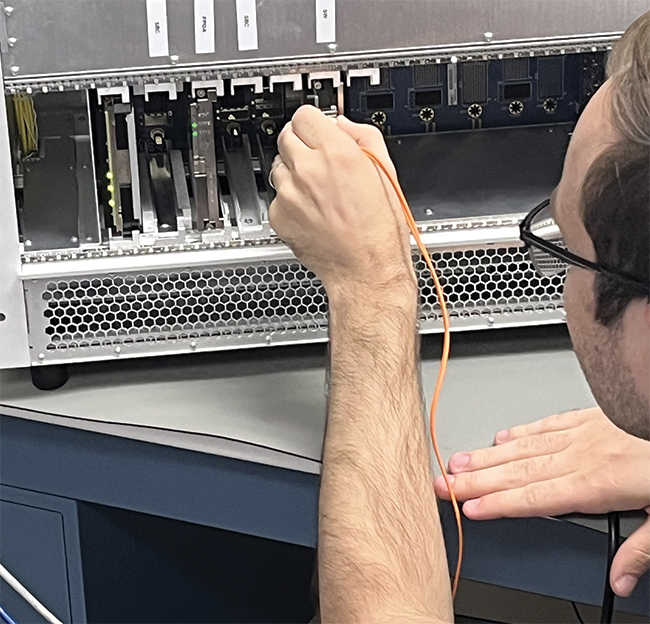
Staring, rather than scanning, allows more rapid detection of adversarial pulses, enabling faster response and greater protection for U.S. military aircraft. The cost-efficient, digital ultra-wideband receiver (UWR) technology provides near-instant detection of signals across a wider swath of the electromagnetic spectrum, expanding capabilities to jam enemy radar.
“The U.S. must stay ahead of potential combatants’ advanced and emerging radars, while operating radio-frequency environments congested with a range of signals, from military radars to cell phone, TV and radio signals,” said SwRI’s Finley Hicks, who leads the development team. “SwRI’s powerful UWR technology is a long-term defense and intelligence solution, overcoming enemy radar systems, even as they increase bandwidth, agility and adaptability.”
The UWR system follows the Sensor Open System Architecture (SOSA™) Technical Standard to easily integrate into legacy and newly developed Open Architecture Weapon systems. Technology aligned to SOSA allows quick and efficient system component updates to support new capabilities without having to replace or redesign the entire system.
Compared to competing systems, the UWR technology improves on size, weight, power and cost (SWaP-C) requirements, delivering an efficient design with fewer components, lower maintenance expenses and a smaller logistical footprint for deployed units.
SwRI Demonstrates Space Software Micropatch
Southwest Research Institute developed an algorithm to remotely update and repair spacecraft software, slashing time and telemetry bandwidth required over conventional techniques.
The tool not only improves the overall efficiency of satellite software transmissions but also can recover data from failed over-the-air updates and malicious cyberattacks. It works by identifying missing bytes and other errors before deploying a custom “micropatch” to the damaged or missing software.
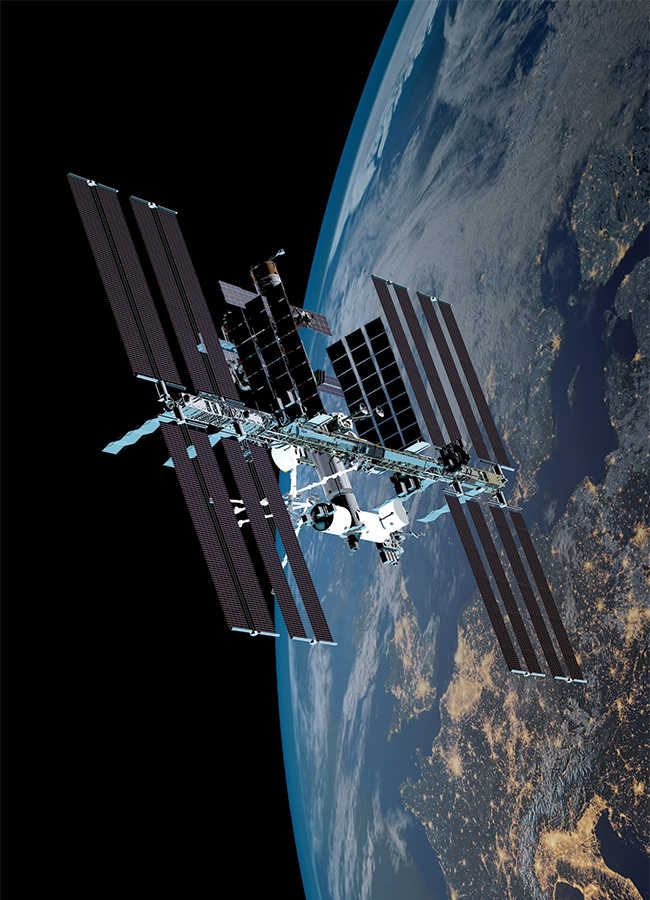
“Instead of updating an entire file or operating system, which is typically required with over-the-air satellite software updates, our tool can find and patch smaller errors,” said Henry Haswell, a research engineer in SwRI’s Intelligent Systems Division.
The researchers successfully deployed and tested the tool on the International Space Station (ISS), working with Axiom Space Inc. and Amazon Web Services (AWS). SwRI uploaded and evaluated the micropatch technology on an Axiom Spaceoperated computer on the ISS. AWS supplied the Snowcone computer to the ISS as part of the Ax-1 mission.
“This real-world demonstration proved the advantages of using this powerful technology,” said Diego Alducin, an SwRI computer scientist.
Updating satellite software through sluggish telemetry networks with limited bandwidth and intermittent contacts can interrupt updates and corrupt files in the process. When that occurs, the current standard is to resend the entire file over the network. However, that typically requires waiting for a window when a satellite is aligned with a ground station. This window can be as short as eight minutes and might only occur once every few days.
Prior to ISS testing, SwRI lab-tested five algorithms, simulating several corruption modes. The lab research identified a double breakpoint search (DBS) algorithm as the most promising solution for Earth-to-space deployment. A DBS patch addresses a variety of complex file errors such as insertion, modification and deletion, while legacy systems can only fix simple issues.
SwRI Delivers MAPS for Moon Mission
SwRI has delivered a plasma spectrometer for integration into a lunar lander as part of NASA’s Lunar Vertex investigation, scheduled to commence next year. The target site is the Reiner Gamma region on the Moon’s nearside, a mysterious area known to have a local magnetic field.
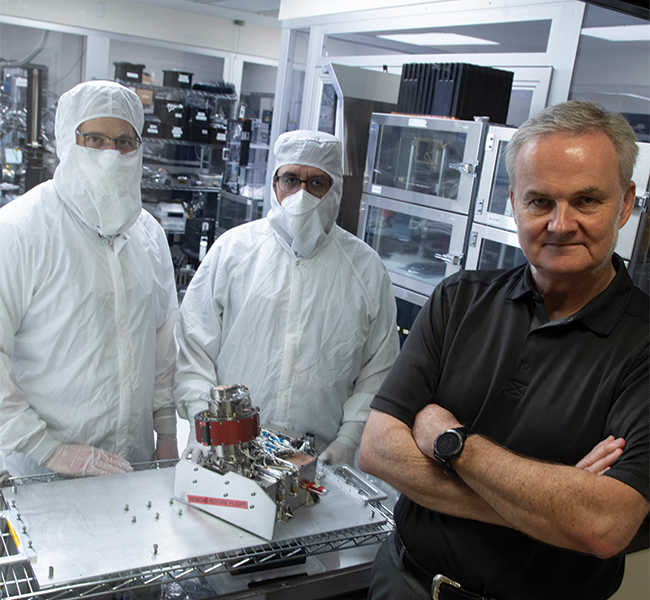
From right, Dr. Jörg-Micha Jahn, MAPS lead investigator, looks on as Benjamin Rodriguez and James Noll prepare the instrument for delivery and integration into NASA’s Lunar Vertex lander. MAPS will gather sensitive, high-resolution insights about the Moon’s surface, offering more than four times the resolution of orbital instruments, while weighing just 11 pounds (five kilograms) and drawing less than 6 watts of power.
The SwRI-developed Magnetic Anomaly Plasma Spectrometer (MAPS) will study the interaction of the solar wind with surface materials on the Moon, aiming to understand the origin of the sinuous patterns of bright and dark soil, known as lunar swirls, that correspond with anomalous regions of magnetic rocks.
“MAPS is the latest generation of the spectrometer that originally flew on ESA’s Rosetta mission to comet 67P/Churyumov-Gerasimenko,” said SwRI’s Dr. Jörg-Micha Jahn, MAPS lead investigator. “We will investigate how the influx of the solar wind interacts with the localized magnetic fields and how it could affect features on the lunar surface. The spectrometer will help us determine if charged particles delivered by the solar wind even make it to the surface of the Moon within a magnetic anomaly.”
Unlike Earth, the Moon does not have a global magnetic field that protects it from the supersonic solar wind. As these streams of energetic particles hit the lunar surface, magnetic patches bend the trajectories of the solar particles, acting like an umbrella.
“The beautiful patterns of bright and dark materials in the magnetic regions could reveal the effects of magnetism on surface weathering,” Jahn said. “Nearby regions not protected by magnetic fields serve as controls. Lunar Vertex could help us quantify space weathering and the relative roles of solar wind exposure versus the effects from cosmic dust hitting the surface. Scientists could then apply this to understand the history and evolution of airless bodies across the solar system.”
JUICE-UVS Collects First Dataset
The SwRI-led Ultraviolet Spectrograph (UVS) aboard ESA’s Jupiter Icy Moons Explorer (JUICE) spacecraft has successfully completed its initial commissioning. The UVS instrument is one of three instrument projects comprising NASA’s contribution to the JUICE mission. The mission’s science goals focus on Jupiter and its system, making multiple flybys of the planet’s large, ocean-bearing satellites with a particular emphasis on investigating Ganymede as a potentially habitable planetary body.

JUICE-UVS successfully completed its initial commissioning en route to Jupiter. This segment of JUICE-UVS data shows a swath of the southern sky, revealing many UV-bright stars in the Milky Way near the southern constellation Carina on the left. The cloud-like structure on the right is a nearby galaxy called the Large Magellanic Cloud.
“Our team of SwRI scientists traveled to Darmstadt, Germany, to put JUICE-UVS through its paces,” said Dr. Randy Gladstone, JUICE-UVS principal investigator. “In June, we opened the UVS aperture door to collect UV light from space for the first time. Soon after, we observed a swath of the Milky Way to verify the instrument was performing well.”
SwRI has provided ultraviolet spectrographs for other spacecraft, including ESA’s Rosetta comet orbiter, as well as NASA’s New Horizons mission to Pluto, Lunar Reconnaissance Orbiter mission in orbit around the Moon and Juno mission to Jupiter.
Weighing just over 40 pounds and drawing only 7.5 watts of power, UVS is smaller than a microwave oven, yet this powerful instrument will determine the relative concentrations of various elements and molecules in the atmospheres of Jupiter’s moons once in the Jovian system. A similar instrument, Europa-UVS, will launch in 2024 aboard NASA’s Europa Clipper, which will take a more direct route to arrive at the Jupiter system 15 months before JUICE and focus on studying the potential habitability of Europa.
“Having two UVS instruments making measurements in the Jupiter system at roughly the same time will offer exciting complementary science possibilities,” said Dr. Kurt Retherford, principal investigator of Europa-UVS and deputy PI for JUICE-UVS.
New Software to Help Decarbonize the Rail Industry
SwRI is helping the freight rail industry assess potential pathways to decarbonization with new open-source modeling and simulation software known as ALTRIOS. ALTRIOS, the Advanced Locomotive Technology and Rail Infrastructure Optimization System, can simulate operational, environmental, infrastructure and financial impacts associated with the adoption of alternative locomotive powertrain technologies.
ALTRIOS supports several simulation modes to assist rail industry stakeholders in their development of optimal technology roadmaps for implementing greenhouse gas emissions (GHG) reduction technologies within their own networks. The largest freight railroads in North America aim to reduce GHG emissions by 40% within the next decade.
ALTRIOS combines locomotive and energy storage technology modeling with a robust suite of train dispatch, train scheduling, and routing tools. These tools enable users to execute realistic, physics-based simulations of individual trains and supporting rail infrastructure to evaluate the effectiveness of different decarbonization technologies — including hydrogen, biofuels and batteries, among many others — across the U.S. over the course of decades.
“The Class-I North American railroads have already committed to reducing their GHG emissions by setting science-based carbon reduction targets,” said Garrett Anderson, a principal engineer in SwRI’s Powertrain Engineering Division. “Railroads are using fuel efficiency, renewable fuels and alternate propulsion approaches to achieve the goal. ALTRIOS can cost-effectively assess locomotive decarbonization approaches using computer modeling to help them choose the right technologies for their needs.”
ALTRIOS was funded by the U.S. Department of Energy’s Advanced Research Projects Agency–Energy (ARPA–E) as part of the LOCOMOTIVES (Lowering CO2: Models to Optimize Train Infrastructure, Vehicles and Energy Storage) program. It received funding of $1.5 million. SwRI helped develop the software with the National Renewable Energy Laboratory (NREL), The University of Texas at Austin, the University of Illinois Urbana-Champaign RailTec and BNSF Railway.
ALTRIOS is publicly available for download under an open-source license and is compatible with Windows, macOS and Linux.
SwRI’s Locomotive Technology Center provided extensive locomotive and railway datasets, simulation and modeling work, and locomotive battery testing expertise to support the ALTRIOS project.

Observing Sources of Solar Energetic Particle Jets
SwRI scientists observed the first close-ups of a source of energetic particles expelled from the Sun, viewing them from just half an astronomical unit (AU), or about 46.5 million miles away. ESA’s Solar Orbiter, a Sun-observing satellite launched in 2020, provided high-resolution images of the solar event.
“In 2022, the Solar Orbiter detected six recurrent energetic ion injections. Particles emanated along the jets, a signature of magnetic reconnection involving field lines open to interplanetary space,” said SwRI’s Dr. Radoslav Bucik, the lead author of a recent study published in Astronomy & Astrophysics in 2023. “The Solar Orbiter frequently detects this type of activity, but this period showed very unusual elemental compositions.”
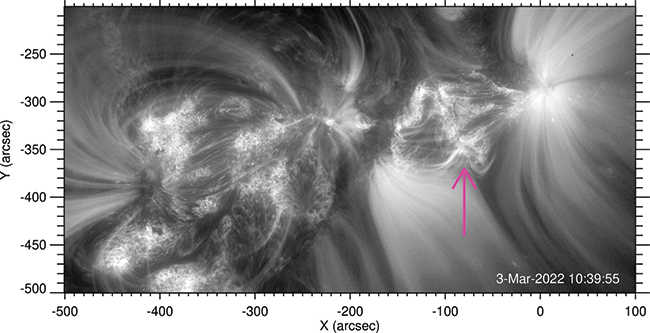
Courtesy of UCAR/Zhang, ET.AL./ NASA/ESA
Using data from ESA’s Solar Orbiter, SwRI scientists observed the first high-resolution close-up views of the source of energetic particle jets expelled from the Sun.
In one ion injection, the intensity of the rare isotope helium-3 exceeded the amount of hydrogen, the Sun’s most abundant element, and the levels of iron were similar to those of isotope helium-4, its second most abundant element. An injection from the same source just two days later measured nearly negligible amounts of helium-3.
“Our analysis shows that the elemental and spectral variations in recurrent injections are associated with the shape of the jet, the size of the jet source and the distribution of the underlying photospheric field that evolved over time,” Bucik said. “We believe that understanding the variability in recurrent events from a single source sheds light on the acceleration mechanism in solar flares.”
The Solar Orbiter observations are unique as the propagation effects that can affect abundances could be minimal near the Sun. Furthermore, the distance of just 0.5 AU has given the scientific team a remarkably detailed view of solar events.
“When we are closer, we have a considerably better spatial resolution and can see the internal structures associated with acceleration processes as injections evolve,” Bucik said. “These observations could ultimately help predict future solar energetic particle events, which can damage satellites and equipment and potentially harm astronauts.”
Giant Swirling Waves At Jupiter’s Magnetic Boundary
A team led by SwRI and The University of Texas at San Antonio (UTSA) has found that NASA’s Juno spacecraft orbiting Jupiter frequently encounters giant swirling waves at the boundary between the solar wind and Jupiter’s magnetosphere. The waves are an important process for transferring energy and mass from the solar wind, a stream of charged particles emitted by the Sun, to planetary space environments.
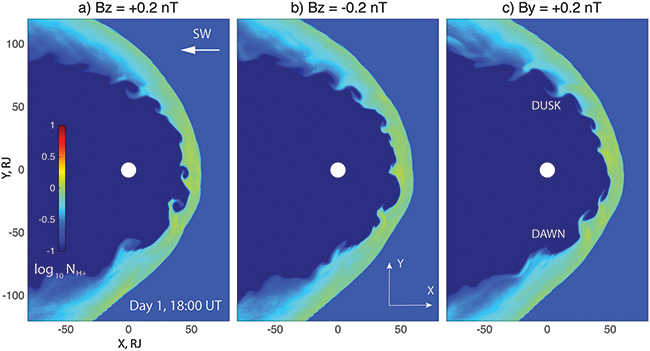
An SwRI-led team identified intermittent evidence of Kelvin-Helmholtz instabilities, giant swirling waves, at the boundary between Jupiter’s magnetosphere and the solar wind that fills interplanetary space, modeled here by University Corporation for Atmospheric Research scientists in a 2017 GRL paper.
Jake Montgomery, a doctoral student in the joint space physics program between UTSA and SwRI, noted that these phenomena occur when a large difference in velocity forms across the boundary between two regions in space. This can create a swirling wave, or vortex, at the interface that separates a planet’s magnetic field and the solar wind, known as the magnetopause. These Kelvin-Helmholtz waves are not visible to the naked eye but can be detected through instrument observations of plasma and magnetic fields in space. Plasma — a fundamental state of matter made up of charged particles, ions and electrons — is ubiquitous across the universe.
“Kelvin-Helmholtz instabilities are a fundamental physical process that occurs when solar and stellar winds interact with planetary magnetic fields across our solar system and throughout the universe,” Montgomery said. “Juno observed these waves during many of its orbits, providing conclusive evidence that Kelvin-Helmholtz instabilities play an active role in the interaction between the solar wind and Jupiter.”
Montgomery is the lead author of a study published in Geophysical Research Letters that uses data from multiple Juno instruments, including its magnetometer and the SwRI-built Jovian Auroral Distributions Experiment (JADE).
“Juno’s extensive time near Jupiter’s magnetopause has enabled detailed observations of phenomena such as Kelvin-Helmholtz instabilities in this region,” said Dr. Robert Ebert, a staff scientist at SwRI who also serves as an adjoint professor at UTSA.

